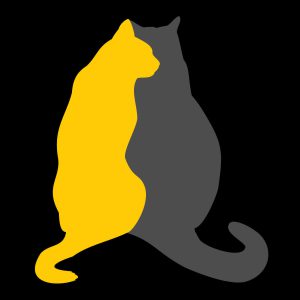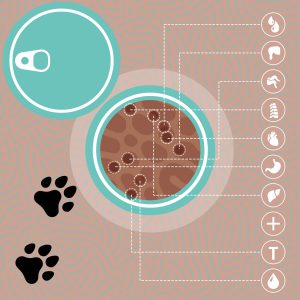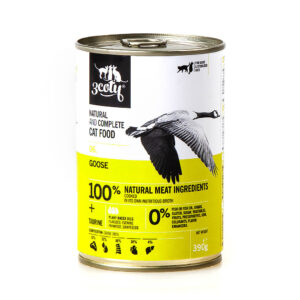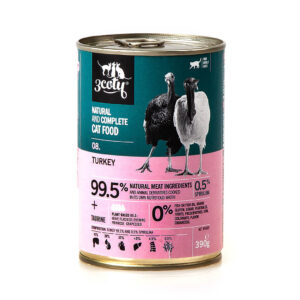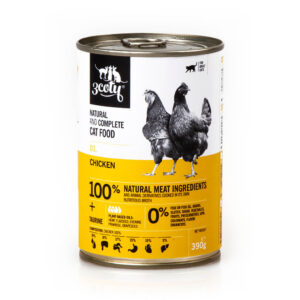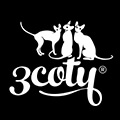Cats like routine and are not keen on change. Introducing anything new to them can take time. This applies to a new food as much as a new home or a new fellow animal in the household. Knowing what to expect and how to manage changing to new cat food will help you and your cat adjust to the change.
We know that some food manufacturers add aromas and flavourings to their foods, which means that our cat food can smell quite different to what a cat is used to. And cats have a very strongly developed sense of smell. Because the new food does not smell like the old food, the cat may not recognise the food and choose not to eat it. Even when we humans know that reducing certain foods is healthier and we should stop eating them, it is still difficult to make the change. For your cat, who doesn’t know that the new food is healthier, it is even harder.
Introducing changes slowly makes it easier for your cat to understand and get comfortable with the change. For some changes, like moving house, it is not easy to make a gradual introduction. Luckily, when it comes to the transition of cat food, it is easier.
We have summarised our recommended transition on this cat food transition chart that you can use as a quick reference. An important part of this changeover is to put both types of food (the previous and 3coty®) into the same bowl. That way your cat will learn that although they may smell different, they are both food for them. Substituting cat food without a transition may upset your pet and the cat won’t eat the new food. Putting both the old and the new food in the same bowl and making the change slowly should mean that your cat will eventually eat his new food.
We also know that you know your cat better than we ever can. Keep an eye on your pet and although we present recommendations/guidelines, we suggest that apply common sense to their reaction and adjust the feeding accordingly. Toilet behaviours of cats who were not on a 100% meat diet before are likely to change. Your cat’s stool colour, consistency and frequency may slowly start altering. Do not get too concerned about the natural adjustment of stool to a firmer consistency and with larger intervals. Cats on meat only diet can poop at larger intervals than those who also consume carbohydrates. This does not necessarily mean they are constipated.
Especially when making changes to food for cats suffering from health problems, it’s important to slowly ease them onto their new meal plan. Switching cat food too quickly could worsen existing health problems or cause new ones, such as vomiting or diarrhoea. The main reason why cats are sick after changing food is that the transition was too fast.
Introduction
Day one and two, alternatively first and second meal
If your cat was used to wet food before, we recommend continuing to put about 75% of their usual meal amount into the bowl, adding about 25% 3coty® food to the same bowl. We suggest you do this for the first day or two, or at least the first two meals and only move on to the higher proportion once your cat has become familiar with and eaten the 3coty® food in its bowl.
25% 3coty® – 75% current food
If the cat does not eat the new food when it is only 25% of the bowl, don’t worry too much. Having it in the bowl with the previous brand helps them become familiar with the new food and learn to trust its smell. They will have the confidence to start eating the new food soon enough.
Particularly if your cat previously only ate dry food, the change to 3coty® is quite big. Not only does their nose and mouth become familiar with the new smell and consistency, but their digestive system also needs to get used to the changed meat and carbohydrate content of the food.
Dry food must contain carbohydrates, often in the form of grains or vegetables, to provide enough ‘stick’ for the biscuit pieces to stick together. Cats have not evolved to consume carbohydrates. Cats in the wild chase and eat small animals, they do not dig up root vegetables or eat fruits. So cats who predominantly eat dry food consume more food ‘material’ as it were then they would need if they only ate meat because their digestive system cannot process the carbohydrates and they just pass through.
You may decide not to move on to the second or third stage until your cat has started eating the 3coty® as well as the other food. This is perfectly fine. The rate of transition should suit you and your cat. This is not a medication that needs to follow strict rules, this is familiarisation and adjustment to change. Everybody has their own comfort level when it comes to adjusting to change.
Fifty-fifty
Day three and four, alternatively third and forth meal
Once your cat has become content with the new food, you can change the proportions to 50/50 for the next day or two or the next meal or two.
50% 3coty® – 50% current food
In our experience, cats transitioning from BARF to 3coty® natural cat food take less time to accept their new food. We think this is because of a couple of reasons. Neither BARF nor 3coty® contain any added flavourings. A BARF fed cat will therefore not miss any artificial aromas in their new food. Many BARF feeders also change the content of their cat’s food bowl. Not every meal consists of the same raw meat. Encountering 3coty® 100% meat cat food is therefore not that unusual.
The similarity of 3coty® wet food to BARF food also makes it an ideal convenient alternative to BARF. For example, if someone else is caring for your cat temporarily, leaving tins of 3coty® food for the cat will be easier than giving instructions on de-frosting and preparation of BARF meals. And when travelling with a show cat it is much easier to carry some tins than finding a way to keep BARF food cold, so it does not spoil.
Almost there
Day five or six, alternatively fifth or sixth meal
By day or meal 5, the cat should by now be happy with its food smelling different, of the meat it wants to eat rather than any aromas or flavourings which were added. We still suggest about 25% of its old food remains available not least for the digestive system to get used to the change in what it is processing.
75% 3coty® – 25% current food
As mentioned above, especially when moving from dry food, the amount of food your cat eats may reduce, because they are no longer eating unnecessary carbohydrates. This could also be the case when moving from some wet foods to 3coty® because many of them also contain unnecessary ingredients. Coupled with the less going in is of course that less comes out! Don’t be concerned if you find less poo in the litter box than before. This is a sign that more of what your cat is eating is being processed and used by its digestive system and therefore less bulk is left over.
You may also find that the consistency and odour of your litter box contents changes. Cats are hunters but also prey in the wild. This means that unlike some animals (rhinoceros) who use their faeces to mark their territory by smell, cat faeces have no strong odour in the wild to better conceal the cat and its toilet. By eating what is natural for a cat in the wild, its excrement will adjust to the natural consistency and smell.
Only meat, naturally
Day seven, or seventh meal
By the end of the first week, both the cat’s flavour receptors and digestive system should have acclimatised to 3coty® natural cat food and the whole bowl can be the meat-only diet from our tins. The gradual change has avoided any “changing cat food problems”.
100% 3coty®
Another change you are likely to observe, especially when changing from dry food, is a reduction in drinking. And at the same time no change to urination, or even an increase. This is a good thing! Cats are desert animals, who have a low thirst drive. Many cats eating only dry food do not consume enough liquid because their urge to drink is so low. This can lead to kidney problems which may go undiagnosed for a long time. In the wild, cats’ liquid intake is covered by the moisture of the animals they eat. As owners, we can reproduce this in the home by feeding our cats wet food.

